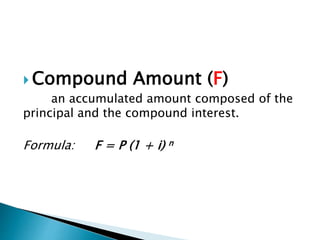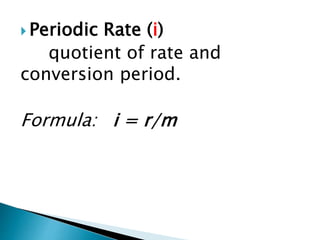Compound interest
- 2. ï― Compound Interest (I) an interest resulting from the periodic addition of simple interest to the principal amount. Formulas: I = F â P and I = P [ (1 + i) n â 1]
- 3. ï― Compound Amount (F) an accumulated amount composed of the principal and the compound interest. Formula: F = P (1 + i) n
- 4. ï― Compounding or Conversion period (m) number of times in a year the interest will be compounded.
- 5. ï― annually ; m = 1 ï― semi-annually; m = 2 ï― quarterly; m = 4 ï― monthly; m = 12 ï― weekly; m = 52 ï― daily; m = 360
- 6. ï― Total Number of Conversion Period (n) product of time (number of years) and the conversion period. Formula: n = tm
- 7. ï― Periodic Rate (i) quotient of rate and conversion period. Formula: i = r/m
- 8. Note: If the conversion period is not indicated in the problem, then it is assumed to be compounded annually, so m = 1.
- 9. Example 1: Find the compound amount and compound interest of P 4,000 for 4 years and 6 months compounded at 4% semi-annually.
- 10. Example 2: Robbie wanted to put his money of P 38,000 in a bank so that it will grow but he put it in a bank that will compound his money semi-annually at 7% by 3 years and 2 months. What is the compound interest?
- 11. Example 3: Accumulate P 16,000 in 16 months at 16% semi-annually.

![ï― Compound Interest (I)
an interest resulting from the periodic
addition of simple interest to the principal
amount.
Formulas: I = F â P and
I = P [ (1 + i) n â 1]](https://image.slidesharecdn.com/compondinterest-150713112739-lva1-app6892/85/Compound-interest-2-320.jpg)








